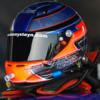My Approach to a Session
I choose the track that I will be racing at next. Then to start my session, I typically I select one of the fastest cars on iRacing, the Honda HPD-ARX 01c Prototype with its massive ground effects down force. It is not as quick as the F1 or Indy cars, but it is easier to drive, and the ground effects allow you to carry much more speed through the faster turns, running much quicker lap times than the Mazda MX-5 Cup car.
Which means that get in way more laps for the same amount of seat time.
I always run my car with the reference lap display set to “best session lapâ€. This gives you instantaneous predictive heads up display of your lap and whether your change is making you faster or slower. I also like to have my reference shadow car switched on, as it is another immediate display of what is working or not working, and it also means that I get the feeling or racing under pressure (from myself)!
In terms of car setup, I run all my non-MX-5 Cup cars in their default setup. However I do play extensively with setup in the MX-5 Cup car but the default setup is fine to get started with.
Apex Choices
I slowly work up to pace running an instinctive line, and when I am able to run around 10 consecutive laps within a few tenths of each other, I then start working at changing my braking points, turn in points, apexes, and throttle application. For the most part, this is seeing what happens when I target an apex that is possibly 2-5 ft later than what I am instinctively running.
I identify a reference mark on the track after the exit of the turn and check to see what my exit speed is as I hit the mark. Just moving the apex a few foot earlier or later might can have significant affect on your ability to commit to WOT and that will transfer to faster exit speeds, and this translates to faster lap times
In real life, on a certain track their might be one specific turn where you feel that you are giving up time in your race car. You know you are competitive everywhere else so it makes sense to dedicate your sim session to finding out what you are doing wrong.
For example, despite living in Florida, I don’t have a lot of track time at Daytona, and I have been typically weak exiting the bus-stop, but able to hang pretty much everywhere else. So before the runoffs this year I practiced the bus-stop almost exclusively, running through the turn, accelerating out of it a checking my exit speed at a certain reference marker on the track. I would brake, turn around drive back and do it again. I did several thousand bus-stops first in high down force cars, then moving to fast mechanical grip cars and eventually to the MX-5 Cup car. Everything that I learned in the high down force cars transferred to the Mx-5 and when I arrived for testing at Daytona, I was one of the fastest through the bus-stop.
NOTE - The predictive timer will not work when you run only portions of a lap so you will need to check your exit speed at a reference point to see what effect your technique is getting
Braking approach
In real life I am typically a late threshold braker. But iRacing has really taught me the value of both trail braking and left foot braking
Running the sequential shift cars in iRacing trained me to left foot brake, and I now practice left foot braking to and from work every day. I am still a right foot braker but I now have much better feel in my left foot and this is a direct result of iRacing sim practice.
There are many tracks where trail braking is critical, often to help rotate the car, but also to help set the nose. Some corners even respond well to slight left foot brake application to set the nose and keep the car planted close to the apex.
As before, once I am able to consistently run at least 10 laps within a few tenths of each other, I then start experimenting with threshold braking, progressive braking as well as trail braking, not forgetting slight dabs of the left foot to help settle the nose through turns. As before I will run through the same specific corner hundreds of times, and drive back to have another stab at it, each time checking my exit speed at a reference marker.
Putting it all together
After a while things will start to come together. You might find your instinctive approach was the best, but often you will find that there is another way through the turn that yields even better exit speeds, without giving up too much in the braking zone.
Also corners where you might have threshold braked, you might find that applying progressive braking pressure holding onto a hint of trail braking and voila, you get a completely settled car that hugs the apex, allowing you to get to WOT even sooner than before.
Now go and run around twenty full laps, applying what you have learned in the individual corners, and see how it compares to your previous session laps. In my own case, almost without fail, my exit speeds improve and my lap times drop.




 Sign In
Sign In Create Account
Create Account













 Back to top
Back to top Report
Report















